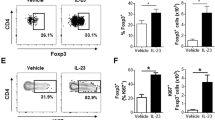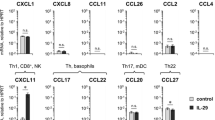Abstract
Alopecia areata (AA) is a condition in which hair is lost in small regions or over the entire body. It has a prevalence of 1 in 1000 and has a great impact on psychological wellbeing. AA is generally considered an autoimmune disease in which a collapse of the immune privilege system of the hair follicle has shown to play an important role, potentially driven by interferon gamma (IFN-γ). The most prominent cells located in or around the hair follicle in AA are Langerhans cells, CD4+ or CD8+ T cells, macrophages and mast cells. Langerhans cells, specialized dendritic cells, are resident in the epidermis and are known to associate with hair follicles. Therefore, we aimed to develop in vitro generated Langerhans cells contributing as an in vitro model of disease. In vitro models provide insight into the behaviour of cells and are a valuable tool before being in need of an animal model or patient samples. For this, Langerhans-like cells were generated from CD14+ monocytes in the presence of GM-CSF and TGF-β. After 10 days of cell culture, Langerhans-like cells express CD207 and CD1a but lack CD209 expression as well as Birbeck granules. Next, Langerhans-like cells were exposed to inflammatory conditions and the effect of different AA treatments was investigated. All treatments—diphencyprone contact immunotherapy, UV-B light therapy and JAK-STAT inhibition—affect the expression of costimulatory and skin-homing markers on Langerhans-like cells. Importantly, also the T cell stimulatory capacity of Langerhans-like cells was significantly reduced following treatment under inflammatory conditions. Noteworthy, JAK-STAT inhibition outperformed conventional AA treatments. In conclusion, our findings demonstrate that in vitro generated Langerhans-like cells can be used as a model of disease. Moreover, JAK-STAT inhibition may become a valuable new approach for the treatment of AA.





Similar content being viewed by others
References
Villasante FAC, Miteva M. Epidemiology and burden of alopecia areata: a systematic review. Clin Cosmet Investig Dermatol. 2015;8:397–403.
Hordinsky MK. Overview of alopecia areata. J Investig Dermatol Symp Proc. 2013;16(1):S13–5.
Majid I, Keen MA. Alopecia areata: an update. Br J Med Pract. 2012;5(3):880.
Chelidze K, Lipner SR. Nail changes in alopecia areata: an update and review. Int J Dermatol. 2018;57(7):776–83.
Rodgers AR. Why finding a treatment for Alopecia Areata is important: a multifaceted perspective. J Investig Dermatol Symp Proc. 2018;19(1):S51-s53.
Hunt N, McHale S. The psychological impact of alopecia. BMJ (Clinical research ed). 2005;331(7522):951–3.
Azzawi S, Penzi LR, Senna MM. Immune privilege collapse and alopecia development: is stress a factor. Skin Appendage Disord. 2018;4(4):236–44.
Biran R, Zlotogorski A, Ramot Y. The genetics of alopecia areata: new approaches, new findings, new treatments. J Dermatol Sci. 2015;78(1):11–20.
Paus R, Slominski A, Czarnetzki BM. Is alopecia areata an autoimmune-response against melanogenesis-related proteins, exposed by abnormal MHC class I expression in the anagen hair bulb? Yale J Biol Med. 1993;66(6):541–54.
Paus R, et al. The hair follicle and immune privilege. J Invest Dermatol Symp Proc. 2003;8(2):188–94.
Niederkorn JY. See no evil, hear no evil, do no evil: the lessons of immune privilege. Nat Immunol. 2006;7(4):354–9.
Cotsarelis G, Sun TT, Lavker RM. Label-retaining cells reside in the bulge area of pilosebaceous unit: implications for follicular stem cells, hair cycle, and skin carcinogenesis. Cell. 1990;61(7):1329–37.
Mitchell AJ, Krull EA. Alopecia areata: pathogenesis and treatment. J Am Acad Dermatol. 1984;11(5):763–75.
Whiting DA. The histopathology of alopecia areata in vertical and horizontal sections. Dermatol Ther. 2001;14(4):297–305.
Ito T, et al. CXCL10 produced from hair follicles induces Th1 and Tc1 cell infiltration in the acute phase of alopecia areata followed by sustained Tc1 accumulation in the chronic phase. J Dermatol Sci. 2013;69(2):140–7.
Zhang X, et al. Lesional infiltration of mast cells, langerhans cells, T cells and local cytokine profiles in alopecia areata. Arch Dermatol Res. 2015;307(4):319–31.
Sterkens A, Lambert J, Bervoets A. Alopecia areata: a review on diagnosis, immunological etiopathogenesis and treatment options. Clin Exp Med. 2021;2:6668.
Flórez-Grau G, et al. Tolerogenic dendritic cells as a promising antigen-specific therapy in the treatment of multiple sclerosis and neuromyelitis optica from preclinical to clinical trials. Front Immunol. 2018;9(1169):9004.
Chung CYJ, et al. Dendritic cells: cellular mediators for immunological tolerance. Clin Dev Immunol. 2013;2013:972865.
Cannon MJ, et al. The evolving clinical landscape for dendritic cell vaccines and cancer immunotherapy. Immunotherapy. 2019;11(2):75–9.
Caux C, et al. CD34+ hematopoietic progenitors from human cord blood differentiate along two independent dendritic cell pathways in response to GM-CSF+TNF alpha. J Exp Med. 1996;184(2):695–706.
Jaatinen T, Laine J. Isolation of mononuclear cells from human cord blood by Ficoll-Paque density gradient. Curr Protoc Stem Cell Biol. 2007;2:50098.
Geissmann F, et al. TGF-beta 1 prevents the noncognate maturation of human dendritic Langerhans cells. J Immunol. 1999;162(8):4567–75.
Geissmann F, et al. Transforming growth factor beta1, in the presence of granulocyte/macrophage colony-stimulating factor and interleukin 4, induces differentiation of human peripheral blood monocytes into dendritic Langerhans cells. J Exp Med. 1998;187(6):961–6.
Picarda G, et al. Functional Langerin high-expressing Langerhans-like cells can arise from CD14-high CD16-human blood monocytes in serum-free condition. J Immunol. 2016;196(9):3716–28.
Geissmann F, et al. Accumulation of immature Langerhans cells in human lymph nodes draining chronically inflamed skin. J Exp Med. 2002;196(4):417–30.
Takayama K, et al. IL-4 inhibits the migration of human Langerhans cells through the downregulation of TNF receptor II expression. J Invest Drmatol. 1999;113(4):541–6.
Nguyen VA, et al. CD34+ -derived Langerhans cell-like cells are different from epidermal Langerhans cells in their response to thymic stromal lymphopoietin. J Cell Mol Med. 2011;15(9):1847–56.
Hoath SB, Leahy DG. The organization of human epidermis: functional epidermal units and phi proportionality. J Invest Dermatol. 2003;121(6):1440–6.
Strunk D, et al. Generation of human dendritic cells/Langerhans cells from circulating CD34+ hematopoietic progenitor cells. Blood. 1996;87:1292–302.
Borkowski TA, et al. A role for endogenous transforming growth factor beta 1 in Langerhans cell biology: the skin of transforming growth factor beta 1 null mice is devoid of epidermal Langerhans cells. J Exp Med. 1996;184(6):2417–22.
Lichtman MK, Otero-Vinas M, Falanga V. Transforming growth factor beta (TGF-β) isoforms in wound healing and fibrosis. Wound Repair Regen. 2016;24(2):215–22.
Kaplan DH, et al. Autocrine/paracrine TGFbeta1 is required for the development of epidermal Langerhans cells. J Exp Med. 2007;204(11):2545–52.
Ebner S, et al. Expression of C-type lectin receptors by subsets of dendritic cells in human skin. Int Immunol. 2004;16(6):877–87.
Fehres CM, et al. In situ delivery of antigen to DC-SIGN(+)CD14(+) dermal dendritic cells results in enhanced CD8(+) T-cell responses. J Invest Dermatol. 2015;135(9):2228–36.
Steinman RM, et al. The induction of tolerance by dendritic cells that have captured apoptotic cells. J Exp Med. 2000;191(3):411–6.
Romani N, et al. Langerhans cells dendritic cells of the epidermis. APMIS. 2003;111(7):725–40.
Streilein JW, Grammer SF. In vitro evidence that Langerhans cells can adopt two functionally distinct forms capable of antigen presentation to T lymphocytes. J Immunol. 1989;143(12):3925.
Cools N, et al. Balancing between immunity and tolerance: an interplay between dendritic cells, regulatory T cells, and effector T cells. J Leukoc Biol. 2007;82(6):1365–74.
Cools N, et al. Regulatory T cells and human disease. Clin Dev Immunol. 2007;2007:89195.
Kimber I, et al. Classification of contact allergens according to potency: proposals. Food Chem Toxicol. 2003;41(12):1799–809.
Land WG. The role of damage-associated molecular patterns in human diseases: part I-promoting inflammation and immunity. Sultan Qaboos Univ Med J. 2015;15(1):e9–21.
Wang EHC, et al. Identification of autoantigen epitopes in Alopecia Areata. J Invest Dermatol. 2016;136(8):1617–26.
Jux B, Kadow S, Esser C. Langerhans cell maturation and contact hypersensitivity are impaired in aryl hydrocarbon receptor-null mice. J Immunol. 2009;182(11):6709–17.
Heufler C, Koch F, Schuler G. Granulocyte/macrophage colony-stimulating factor and interleukin 1 mediate the maturation of murine epidermal Langerhans cells into potent immunostimulatory dendritic cells. J Exp Med. 1988;167(2):700–5.
Peiser M, Wanner R, Kolde G. Human epidermal Langerhans cells differ from monocyte-derived Langerhans cells in CD80 expression and in secretion of IL-12 after CD40 cross-linking. J Leukoc Biol. 2004;76(3):616–22.
Picker LJ, et al. ELAM-1 is an adhesion molecule for skin-homing T cells. Nature. 1991;349(6312):796–9.
Sernicola A, et al. Targeting the cutaneous lymphocyte antigen (CLA) in inflammatory and neoplastic skin conditions. Expert Opin Biol Ther. 2020;20(3):275–82.
Yasaka N, Furue M, Tamaki K. Expression of cutaneous lymphocyte-associated antigen defined by monoclonal antibody HECA-452 on human Langerhans cells. J Dermatol Sci. 1996;11(1):19–27.
Kubo S, et al. The JAK inhibitor, tofacitinib, reduces the T cell stimulatory capacity of human monocyte-derived dendritic cells. Ann Rheum Dis. 2014;73(12):2192–8.
Azuma M, et al. B70 antigen is a second ligand for CTLA-4 and CD28. Nature. 1993;366(6450):76–9.
Inaba K, et al. The tissue distribution of the B7–2 costimulator in mice: abundant expression on dendritic cells in situ and during maturation in vitro. J Exp Med. 1994;180(5):1849–60.
Inaba K, et al. Expression of B7 costimulator molecules on mouse dendritic cells. Adv Exp Med Biol. 1995;378:65–70.
Freeman GJ, et al. Structure, expression, and T cell costimulatory activity of the murine homologue of the human B lymphocyte activation antigen B7. J Exp Med. 1991;174(3):625–31.
Freeman GJ, et al. Cloning of B7–2: a CTLA-4 counter-receptor that costimulates human T cell proliferation. Science. 1993;262(5135):909–11.
Borriello F, et al. B7–1 and B7–2 have overlapping, critical roles in immunoglobulin class switching and germinal center formation. Immunity. 1997;6(3):303–13.
Sharpe AH. Analysis of lymphocyte costimulation in vivo using transgenic and “knockout” mice. Curr Opin Immunol. 1995;7(3):389–95.
Reise SC. Dendritic cells in a mature age. Nat Rev Immunol. 2006;6(6):476–83.
Kryczanowsky F, et al. IL-10-modulated human dendritic cells for clinical use: identification of a stable and migratory subset with improved tolerogenic activity. J Immunol. 2016;197(9):3607–17.
Yamazaki S, et al. Direct expansion of functional CD25+ CD4+ regulatory T cells by antigen-processing dendritic cells. J Exp Med. 2003;198(2):235–47.
Freyschmidt-Paul P, et al. Interferon-gamma-deficient mice are resistant to the development of alopecia areata. Br J Dermatol. 2006;155(3):515–21.
Bhat P, et al. Interferon-γ derived from cytotoxic lymphocytes directly enhances their motility and cytotoxicity. Cell Death Dis. 2017;8(6):e2836–e2836.
Xing L, et al. Alopecia areata is driven by cytotoxic T lymphocytes and is reversed by JAK inhibition. Nat Med. 2014;20(9):1043–9.
Berekmeri A, et al. Tofacitinib for the treatment of psoriasis and psoriatic arthritis. Expert Rev Clin Immunol. 2018;14(9):719–30.
Craiglow BG, King BA. Killing two birds with one stone: oral tofacitinib reverses alopecia universalis in a patient with plaque psoriasis. J Invest Dermatol. 2014;134(12):2988–90.
Jabbari A, et al. Treatment of an alopecia areata patient with tofacitinib results in regrowth of hair and changes in serum and skin biomarkers. Exp Dermatol. 2016;25(8):642–3.
Kennedy Crispin M, et al. Safety and efficacy of the JAK inhibitor tofacitinib citrate in patients with alopecia areata. JCI Insight. 2016;1(15):e89776.
Mackay-Wiggan J, et al. Oral ruxolitinib induces hair regrowth in patients with moderate-to-severe alopecia areata. JCI Insight. 2016;1(15):e89790.
Acknowledgements
We thank the Antwerp Centre for Advanced Microscopy (ACAM) of the University of Antwerp for support with the TEM analysis.
Funding
The authors have not disclosed any funding.
Author information
Authors and Affiliations
Contributions
Conceptualization: A.S. & N.C. Data collection: A.S. Experimental Support: H.DR. & L.V. Data analysis: A.S. & N.C. Writing - original draft preparation: A.S. & N.C. Writing - review and editing: A.S, N.C., I.J. & M.M. Visualization: A.S. & N.C. Supervision: N.C. Funding acquisition: J.L., N.C., A.B. All authors have read and agreed to the published version of the manuscript.
Corresponding author
Ethics declarations
Conflict of interest
The authors have not disclosed any conflict of interest.
Additional information
Publisher's Note
Springer Nature remains neutral with regard to jurisdictional claims in published maps and institutional affiliations.
Supplementary Information
Below is the link to the electronic supplementary material.
Rights and permissions
Springer Nature or its licensor holds exclusive rights to this article under a publishing agreement with the author(s) or other rightsholder(s); author self-archiving of the accepted manuscript version of this article is solely governed by the terms of such publishing agreement and applicable law.
About this article
Cite this article
Ann, S., Ibo, J., Megha, M. et al. Treatment of in vitro generated Langerhans cells with JAK-STAT inhibitor reduces their inflammatory potential. Clin Exp Med 23, 2571–2582 (2023). https://doi.org/10.1007/s10238-022-00899-w
Received:
Accepted:
Published:
Issue Date:
DOI: https://doi.org/10.1007/s10238-022-00899-w




